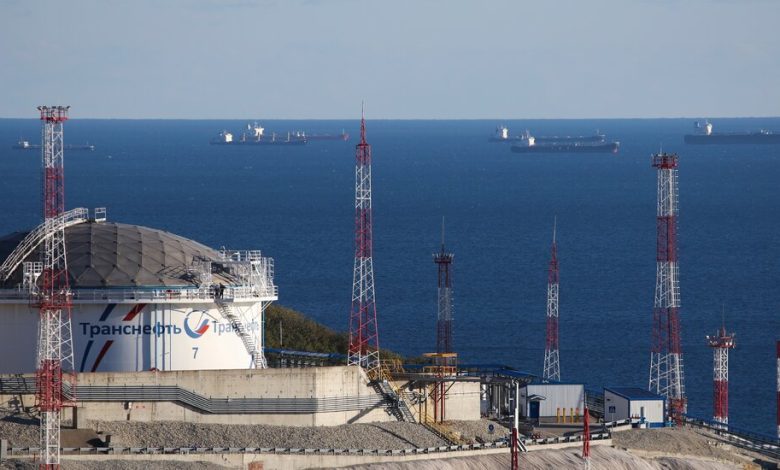Biden Seeks to Tame Oil Prices if Mideast Conflict Sends Them Soaring

Biden administration officials, worried that a growing conflict in the Middle East could send global oil prices soaring, are looking for ways to hold down American gasoline prices if such a jump occurs.
Those efforts include discussions with large oil-producing nations like Saudi Arabia that are holding back supply and with American oil producers who have the ability to pump more than they already are producing, administration officials say.
A senior administration official said in an interview that it was also possible the president could authorize a new round of releases from the nation’s Strategic Petroleum Reserve, an emergency stockpile of crude oil that is stored in underground salt caverns near the Gulf of Mexico. President Biden tapped the reserve aggressively last year after Russia’s invasion of Ukraine sent oil prices skyrocketing, leaving the amount of oil in those reserves at historically low levels.
The conflict in the Middle East has not yet sent oil prices surging. A barrel of Brent crude oil was trading for about $88 on global markets on Wednesday. That’s up from about $84 a barrel earlier this month, shortly before Hamas attacked Israel and rattled markets. But analysts and administration officials fear prices could rise significantly more if the conflict in Israel spreads, restricting the flow of oil out of Iran or other major producers in the region.
So far, American drivers have not felt a pinch. The average price of gasoline nationally was $3.54 a gallon on Wednesday, according to AAA. That was down about 30 cents from a month ago and 25 cents from the same day last year.
Administration officials are wary of the possibility that prices could again jump above $5 a gallon, a level they briefly touched in the spring of 2022. Mr. Biden took extraordinary efforts then to help bring prices down — but those steps are likely to be far less effective in the event of a new oil shock.
“They succeeded last year in the second half, but this year I think they’ve kind of run out of bullets,” said Amrita Sen, director of research at Energy Aspects.
In part that’s because the administration did not refill the strategic reserve more aggressively when prices were lower, Ms. Sen said. That could undercut their ability to counteract rising prices now. “They got a little overconfident that prices would stay low,” she said. “In some ways, they’ve missed the boat.”
Mr. Biden released a record 180 million barrels of oil from the strategic reserve, flooding the market with additional supply. His administration replenished just six million barrels when prices dipped earlier this year, leaving the reserve at its lowest level since the 1980s. The Energy Department announced plans last week to continue refilling in the months ahead, but only if prices drop below $79 a barrel.
Administration officials insist that tapping the reserve again remains an option. It still holds more than 350 million barrels of oil. That’s more than enough to counteract a disruption in oil markets if one were to occur, energy analysts say.
The U.S. economy is also less vulnerable to a price spike than in previous decades because the country has become less dependent on foreign oil. The United States produced more than 400 million barrels of oil in July, a record.
“There’s still a lot of oil in the U.S. strategic reserve, and the U.S. is not in this alone,” said Richard Newell, president and chief executive of Resources for the Future, an energy-focused think tank. He noted that other countries have their own strategic reserves.
Still, with Mr. Biden already taking criticism from Republicans for depleting the stockpile, he may be reluctant to tap it again now.
“There’s another arrow in the quiver but there’s only so many arrows right now,” said Jim Burkhard, head of energy markets research for S&P Global Commodity Insights. “Could they repeat it? Yes, but then you’re left with much, much less oil.”
The stakes for Mr. Biden are high. Voters often punish presidents for high gasoline prices, and the challenge is amplified for Mr. Biden because, unlike most presidents, he has leaned into his role — intervening aggressively when prices soared early last year, and then claiming credit when prices fell.
Independent experts say Mr. Biden is justified in claiming some credit for the moderation in prices last year, though they say other factors — including weaker than expected Chinese oil demand — also played a major role.
The initial jump in oil prices was driven not by an actual shortage of oil but by a fear of one: Investors worried that millions of barrels of Russian oil would be blocked from the international market, either as a result of western sanctions or Russian retaliation.
Mr. Biden’s decision to release oil from the strategic reserve provided additional supply at a crucial moment, helping to calm markets and push prices down.
Analysts worried that additional sanctions from Europe, which were set to take effect near the end of 2022, would cause a second surge in prices by knocking more Russian supply offline. The Biden administration worked to prevent that by leading an international effort to impose a price cap on Russia that allowed the country to keep exporting oil — but only at reduced prices.
That effort has worked to keep Russian oil flowing to markets and avoid a supply shock. In the first half of this year, it also appeared to be denting Moscow’s oil revenues. Increasingly, Russia has found ways around the price cap, forcing administration officials to take steps this month to crack down on enforcement of the cap in hopes of reducing the price at which Russian oil is sold.
There is some risk that those enforcement efforts could at least temporarily knock Russian supply off the market at a tenuous time for global oil supply. But more important for the administration, there is little chance that a similar sort of price cap could help keep supply flowing from a large oil producer that could be involved in a widening war in the Middle East — most notably, Iran.
Last October, the White House announced that it would enter into contracts to buy oil for the strategic reserve when prices fell below $72 a barrel. Doing so, the administration argued, would not just replenish the reserve but would encourage domestic production by guaranteeing demand for oil at a reasonable price. But the effort has gotten off to a fitful start.
Rory Johnston, an oil market analyst, said the administration had been admirably creative in its energy policy, but that its execution had been flawed. Investors, he said, have been left skeptical about the administration’s ability to execute its strategy on refiling the reserve. They are also wondering if Mr. Biden will ever be willing to risk the political hit from driving up oil prices, by buying supply and pulling it off the market to refill the reserve.
“If you want to be cynical, they’re very keen to do the price downside stuff and understandably not as keen to do the things that could seen as lifting prices,” Mr. Johnston said.





